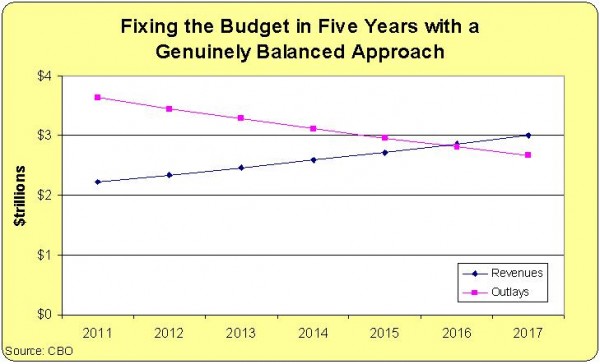The President has issued an ultimatum that more tax revenue must be part of budget negotiations. Indeed, he endlessly repeats his desire for a “balanced approach,” implying that as much as 50 percent of the deficit reduction in any agreement should come from higher revenues.
Because I am a thoughtful, middle-of-the-road, pragmatic guy, I’m willing to accept the President’s ultimatum. I do have one tiny request, however, and that is for any such deal to be based on honest math.
What I mean by this is that I don’t want politicians to approve a budget that results in more spending, but then claim that they “cut spending” because the budget didn’t grow even faster. I want a spending cut to mean less spending (gee, what a novel idea).
And when they talk about new revenue, I want to see how much revenue the IRS is collecting this year, and measure revenue increases against that number. After all, the crowd in Washington should be happy to get more money, even if it is the result of benign factors such as more jobs being created, companies earning higher profits, and people getting more pay.
I assume these are reasonable requests. After all, this is how businesses and households operate their budgets, and I’m sure the political insiders wouldn’t want to use dishonest numbers to mislead voters (perish the thought!).
So what would a balanced approach look like, assuming we want to use honest math? The answer isn’t that complicated. I started with the latest estimates from the Congressional Budget Office for spending and revenues for this fiscal year (FY2011). I then assume, in the interest of a “balanced approach,” that spending should be cut by 5 percent each year and that revenues should climb by 5 percent each year.
The results, as illustrated by the graph, are remarkable. If we use a 50-50 deal of higher revenue and lower spending, we balance the budget in just five years. The President is right!
 Taxpayers will be happy to know the “balanced approach” gets rid of red ink and also leaves enough room to make the 2001 and 2003 tax cuts permanent. Heck, there would be enough left-over revenue to enact additional tax cuts. After all, since we’re looking for balance, there’s no need to let revenues grow by 7 percent or 8 percent each year.
Taxpayers will be happy to know the “balanced approach” gets rid of red ink and also leaves enough room to make the 2001 and 2003 tax cuts permanent. Heck, there would be enough left-over revenue to enact additional tax cuts. After all, since we’re looking for balance, there’s no need to let revenues grow by 7 percent or 8 percent each year.
So, Mr. President, do we have a deal? Should we use your “balanced approach” and eliminate today’s big deficit by cutting spending and raising revenue by equal amounts? You were serious about your request, right? Hello, is anybody there?
As you already realize, I don’t think the President actually means what he says about a “balanced approach.” Or, to be more specific, I think he’s happy to do a 50-50 deal, but only if “spending cuts” and “revenue increases” are defined in ways that enable the growth of government.
Inside the beltway, this is known as “baseline budgeting” or “current services budgeting.” But whatever it’s called, it is a dishonest way of presenting information to the American people, as explained in this video.

